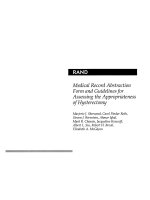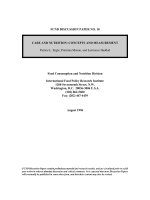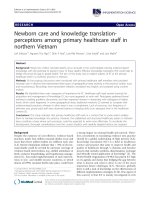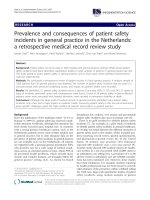pet care and medical record book application
Bạn đang xem bản rút gọn của tài liệu. Xem và tải ngay bản đầy đủ của tài liệu tại đây (1 MB, 15 trang )
<span class="text_page_counter">Trang 1</span><div class="page_container" data-page="1">
<b>Chinh, Duc NguyenTam, Nguyen Phuoc Minh</b>
<b>Approved by Tam, Nguyen Thi Thanh</b>
<b>Proposal Review Panel Representative:</b>
<b>Capstone Project 1- Mentor:</b>
<b>1. Project Overview</b>
<b>PROJECT INFORMATION</b>
</div><span class="text_page_counter">Trang 2</span><div class="page_container" data-page="2"><b>Project acronym</b> PCMRB
<b>Project </b> Pet Care and Medical Record Book application
<b>Lead Institution</b> International School, Duy Tan University
<b>Project Mentor</b> Tam-Nguyen Thi Thanh, MSc
<b> Project Leader & contact details</b>
Kien, Dang Trung
26211234641 Minh, Le Cong
1.0 2024-02-19 Initial document All member
</div><span class="text_page_counter">Trang 4</span><div class="page_container" data-page="4"><b>2. Executive Summary</b>
The goal of The Pet Care and Examination Book app is to give pet owners a practical way to keep track of their pets' medical records, vaccination records, appointment calendars, and other care services. The app will guarantee that pets are in the best possible health and wellbeing, aid with better pet management and care, and increase communication between pet owners and vets.
<b>3. Project Background</b>
Recent years have witnessed a notable increase in the pet market as more individuals view their animals as important members of the family. As a result, there is a growing need for practical and effective ways to oversee pet healthcare and guarantee their wellbeing. But remembering their pet's medical history, vaccination history, and scheduled appointments can be difficult for pet owners.
Traditionally, data related to pet healthcare is dispersed across multiple veterinary offices or kept in physical records, which makes it challenging to keep an accurate and thorough record. A lack of consolidated information can cause delays in obtaining the proper treatment for pets, confusion, and missed immunizations.
To solve these problems, we propose to develop a Pet Care and Medical Record Book application. This app will provide a user-friendly platform for pet owners to manage and organize their pet's healthcare information in one location. The software seeks to ease pet care by digitizing medical records and providing easy access to important information.
<b>4. Project Objectives</b>
<b>Design a User-Friendly Application: The primary goal is to design a mobile application</b>
that is intuitive and simple to use. The app should offer pet owners a streamlined way to maintain their pet's medical records and access critical pet care features.
<b>Pet Health Management: The app should allow owners to keep a detailed record of their</b>
pet's health information, such as medical records, immunization history, allergies, and medications. This goal guarantees that all relevant health data is readily available whenever needed.
<b>Reminder System: The program should provide a reliable appointment scheduling</b>
system that allows pet owners to plan veterinary visits, bathing sessions, cleaning, and other pet care appointments. Furthermore, the app should have a reminder function to notify pet owners of impending visits, vaccines, and other important events.
<b>Data Security and Privacy: It is crucial to prioritize data security and user privacy. The</b>
app should implement robust encryption measures, data backup systems, and comply with privacy regulations to ensure the confidentiality and integrity of pet health information.
<b>User Feedback and Continuous Improvement: The app should provide a feedback</b>
mechanism to collect feedback from pet owners and continuously improve its features and functionalities.
</div><span class="text_page_counter">Trang 5</span><div class="page_container" data-page="5"><b>5. Scope and Requirements5.1 Scope:</b>
The Pet Care and Medical Record Book Application is intended to provide pet owners with a comprehensive tool to manage and track their pets' health and well-being. The software solution will offer a range of features and functions to facilitate efficient pet care management
<b>5.2 Requirements:Functional Requirements:</b>
● Pet Profile Management:
Users can create, view, update, and delete profiles for each pet.
Each profile includes fields for name, species, breed, age, weight, identification details, and primary veterinarian information.
Users can upload photos of their pets. ● Medical Records Tracking:
Users can record veterinary visits, including appointment dates, reason for visit, diagnoses, treatments administered, medications prescribed, and follow-up instructions.
Vaccination records can be stored, including vaccine type, administration dates, and next due dates.
Medical procedures such as surgeries and dental cleanings can be documented. ● Medication Management:
Users can schedule and track medication doses for their pets. The system sends reminders for upcoming doses or medication refills.
Medication details such as dosage instructions and prescribing veterinarian information are stored.
</div><span class="text_page_counter">Trang 6</span><div class="page_container" data-page="6">The system sends reminders for upcoming appointments and notifications for scheduling conflicts.
● Emergency Contacts and Information:
Users can store emergency contact information for veterinarians, pet care providers, and nearby animal hospitals.
Instructions for emergency situations, including first aid procedures or evacuation plans, can be documented.
<b>Non-Functional Requirements:</b>
● Usability:
The application interface is intuitive and easy to navigate.
Response times for user interactions are fast to ensure a smooth user experience.
</div><span class="text_page_counter">Trang 7</span><div class="page_container" data-page="7"><b>5.3. System context </b>
<b>6. Methodology and Approach</b>
For the pet care and medical record book application project, we will adopt the Scrum framework as our project management approach and development methodology. Here's how we'll implement it:
<b>Scrum Roles:</b>
● Product Owner: Responsible for prioritizing features, managing the product backlog, and ensuring that the application meets the needs of the users.
● Scrum Master: Facilitates the Scrum process, removes obstacles, and ensures that the development team adheres to Scrum principles and practices.
● Development Team: Cross-functional team responsible for delivering increments of the product during each sprint.
<b>Product Backlog:</b>
● The Product Owner will create and maintain a prioritized list of features and user stories in the product backlog.
● The backlog will be regularly refined and updated based on feedback, changes in requirements, and evolving priorities.
● Each development cycle will be organized into time-boxed iterations called sprints, typically lasting 1-4 weeks.
● At the beginning of each sprint, the team will conduct sprint planning to select backlog items to work on and define the sprint goal.
● Daily stand-up meetings will be held to provide updates on progress, identify any obstacles, and plan the day's work.
<b>Incremental Development:</b>
</div><span class="text_page_counter">Trang 8</span><div class="page_container" data-page="8">● The development team will work collaboratively to deliver potentially shippable increments of the product at the end of each sprint.
● The product will evolve incrementally, with new features added in each sprint based on user feedback and priorities.
<b>Technical Stack:</b>
● Frontend: HTML, CSS, JavaScript (possibly with frameworks like React or Angular for a more dynamic user interface).
● Backend: Node.js with Express.js for RESTful API development.
● Database: MongoDB for storing pet profiles, medical records, and other relevant data.
● Additional technologies and tools as needed for deployment, testing, and monitoring.
<b>Risk Management:</b>
● Risks will be identified, assessed, and documented regularly throughout the project. ● Mitigation strategies will be developed to address high-priority risks, and
contingency plans will be prepared as needed.
<b>Issue and Change Management:</b>
● Issues and changes will be tracked using a project management tool like Jira or Trello.
● Changes to requirements or scope will be evaluated by the Product Owner and prioritized accordingly in the product backlog.
<b>Communication and Collaboration:</b>
● Regular communication and collaboration will be facilitated through daily stand-up meetings, sprint reviews, and sprint retrospectives.
● The team will use collaboration tools like Slack or Microsoft Teams for real-time communication, and documentation will be maintained in a shared repository for easy access.
By following the Scrum framework, we aim to deliver a high-quality pet care and medical record book application that meets the needs of users while maintaining flexibility to adapt to changes and feedback throughout the development process.
</div><span class="text_page_counter">Trang 9</span><div class="page_container" data-page="9"><b>7. Project Timeline</b>
<b>121 Days22/01/202420/05/2024</b>
1.1 Project Kick-off Meeting 1 day 22/01/2024 22/01/2024 1.2 Discuss about project ideal 2 day 23/01/2024 24/01/2024 1.3 Make Proposal Document 2 day 25/01/2024 26/01/2024 1.4 Make Project Plan Document 1 day 27/01/2024 27/01/2024 1.5 Make Product Backlog Document 1 days 28/01/2024 28/01/2024 1.6 Make User Story Document 2 days 29/01/2024 30/01/2024 1.7 Review Document 1 day 31/01/2024 31/01/2024
3.2 Project Meeting 1 day 19/05/2024 19/05/2024 3.3 Final Submission 1 day 20/05/2024 20/05/2024
</div><span class="text_page_counter">Trang 10</span><div class="page_container" data-page="10"><b>8. Resource Allocation8.1. Human resource</b>
Kien,Trung Dang 0911090445 Leader / Scrum
Android Studio: As our core integrated development environment (IDE) for building the Android app. Includes emulator, debugger, build tools.
Figma: For collaboratively designing and prototyping the user interface and overall app workflow. Enables creating design system.
GitHub: For source code repository to enable version control and centralized code management. Facilitates team collaboration.
MySQL: As the database back-end for storing and managing all pet health records, appointments and user data in a structured format.
Trello: Agile project management via Kanban boards to efficiently track features, issues and progress
Android Devices for Testing: A range of real Android phones and tablets to test app compatibility across different OS versions and screen sizes.
Laptops for Development: Team member personal laptops will be used for coding and development. Specs - 8GB+ RAM, SSD storage preferred.
Cloud hosting: A solid, high availability architecture will be used to host backend database servers, web services APIs, etc. using scalable cloud infrastructure from AWS/Azure.
<b>*Expertise</b>
</div><span class="text_page_counter">Trang 11</span><div class="page_container" data-page="11">Mobile development mentorship - Seek general guidance from experienced Android developers on best practices, rather than specialized domain experts.
<b>9. Budget and Cost Estimate</b>
The following outlines the cost to complete all the identified components for the project.
Based on the project objectives and the scope of producing a minimal viable product with basic functionality, the total projected cost for developing the pet care application is $1,350.
The initial project planning, research, requirement analysis for the solution, and setting up the technical infrastructure required to move forward with development are all included in the start-up costs. Even if the investment is only $150, it is crucial to the project's success as it lays the groundwork for success.
From a financial standpoint, the majority of the work is done during the development stage, which takes place across several sprints. We provide features incrementally using an agile, iterative methodology. The largest percentage of expenses is associated with developer time, which is projected to be two hours per day for features like appointments, health record management, and reminder systems. Development costs go down as we build out the essential functionality during the sprints.
We set $320 for various incidental expenses, which include software licenses, cloud hosting fees, device testing tools, and project management tools, in addition to the direct
</div><span class="text_page_counter">Trang 12</span><div class="page_container" data-page="12">development activities. It takes these auxiliary platforms, services, and technologies to enable a productive, team-based, and integrated development workflow.
In order to guarantee that we offer a stable, workable solution that satisfies client expectations and project objectives, ongoing costs have also been factored in for recurring project meetings, final testing, and quality assurance activities.
Provide a comprehensive cost estimate for the project, broken down into major cost categories (such as development, testing, infrastructure, etc.). Justify the estimated costs by explaining the resource requirements and the value delivered by the proposed solution.
<b>10. Risk Management</b>
There will always be certain risks during development that need to be taken care of. To begin, we have identified a handful, which are given below.
1. Scope creep due to expanding feature requests: Expanding feature requests could lead to scope creep, which is the possibility that the project's capabilities and essential features would be greatly exceeded. Since we just started this project, there’s no telling that we have truly understood our goal. In order to lessen this, we will precisely define and uphold the limitations of the development phase's scope, recording feature requests for review in later iterations.
2. Team member availability/scheduling issues: There is always a chance that the four team members' schedules would clash or that they will become less available due to their hectic university schedules. We will always make sure there is sufficient coverage of crucial tasks like project management and software development, and we will proactively communicate availability/scheduling updates.
3. Software defects that impact user experience: Software flaws that affect user experience: Inadequate testing may lead to flaws that irritate users and harm their adoption and retention. Comprehensive testing of the units, integration, and user acceptability will be done in order to find and fix any issues before the release. After the release, we'll continue to gather and analyze user comments to identify any lingering problems.
4. Security and privacy vulnerabilities:
Security and privacy are critical for an application that handles sensitive pet medical data. During design, we will finish the threat modeling and risk analysis. The implementation of encryption, access controls, and data protection best practices is intended to reduce the risks associated with unauthorized access and exposure.
</div><span class="text_page_counter">Trang 13</span><div class="page_container" data-page="13">Develop Team ● Design, Programming and Development ● Testing and Quality Assurance ● Version and Source Code Management ● Deployment and Support
Project Manager ● Define Scope and Planning ● Manage Risk, Resource, Change and
Quality of Product
● Communication and Collaboration with other Stakeholders
High
</div><span class="text_page_counter">Trang 14</span><div class="page_container" data-page="14"><b>12. Project Constraints </b>
<b>ConstraintConstraints DescriptionGuidelines for AcceptanceEconomic</b> The product will be sold to
parties who want to use it
Elements for consideration are design costs, production costs, maintenance costs, operating costs, and sales price
environment as well as the impact of the environment (e.g. temperature range, humidity, vibration, electromagnetic interference immunity, and shock) on the design should be considered. Design for recycling and design to use recycled materials should also be considered
<b>Ethical</b> Preserving the privacy of user' information and medical records.
Ethical considerations can be broad. Areas that are typically addressed include intellectual property, reverse- engineering, privacy, security, and the conflict between cost and safety
<b>Public health, safety, and welfare</b>
N/A Includes safety standards as well as the impact of the design on users (for example, electrical or physical hazards)
<b>Social and Global</b>
N/A Addresses aspects such as benefits, risks, the man-machine interface, the acceptance of products by the intended user or by society at large, and global and socially responsible engineering.
influence the approach?
How do the designs from different cultures differ?
<b>Sustainability</b> Using technology that is sustainable and consistent with the functions of the system.Perform monitoring and ensure the continuity of the system
Refers to the sustainability of resources, including material, energy, supplies, manufacturing techniques, personnel, operation, and the need for additional infrastructure, as well as the sustainability of the design including reliability, lifetime, durability, reusability, maintainability.
</div>








